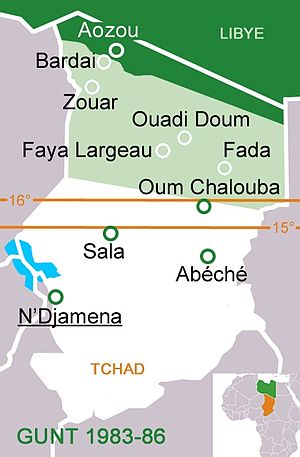Battle for Wadi Dum
| date | March 22, 1987 |
|---|---|
| place | Wadi Dum Air Force Base |
| output | Chadian troops take the base |
| Territorial changes | Libya loses control of Chadian areas north of the 16th parallel |
| Parties to the conflict | |
|---|---|
| Commander | |
|
Hoist Habre |
Muammar al-Ghaddafi |
| losses | |
|
200 |
1269 |
The battle for Wadi Dum was one of the most important skirmishes towards the end of the Libyan-Chadian border war .
prehistory
First French intervention and withdrawal
The Libyan-Chadian border war had been raging since 1978 and had thus seen a large number of alliance changes. For example, in 1983 French troops came to Chad for the first time to prevent further advance of the Libyan armed forces and its allies, particularly the transitional government of national unity (French Gouvernement d'Union Nationale de Transition , GUNT for short). In 1984 Mitterrand and Ghaddafi signed an agreement that prompted the withdrawal of Libyan and French troops from Chad. Nevertheless, Libya retained its position of power in northern Chad between 1984 and 1986 and expanded the military infrastructure there. The important base of Wadi Dum, which was to serve in particular for air support for Libyan operations in Chad, was also created. Contrary to the agreements of the Libyan-French agreement, Ghaddafi increased the Libyan army in the southern neighboring country to 7,000 men, 300 tanks and 60 combat aircraft .
Second French intervention
In the relatively peaceful period between 1984 and 1986, the GUNT recorded more and more defectors , who switched to the hostile FANT around the Chadian President Habre . Ghaddafi tried to counteract this development with an offensive that attacked Habres positions south of Faya Largeau on February 10, 1986 and aimed at N`djamena . Ghadaffi's 10,000-strong army, consisting of Libyans and GUNT supporters, was quickly repulsed and a FANT counter-offensive, carried out with French weapons, forced the Libyans to retreat for the time being. In addition, the offensive provoked a second French intervention in Chad, which among other things led to air strikes against Wadi Dum. These failures of the Libyan coalition led to a break in the GUNT and the loss of all Libyan allies in Chad.
As a result of these changes, the Libyan troops with a strength of 8,000 were inferior to the FANT and their allies, who led 10,000 men into the field. In addition, the Libyans lacked any local support, so they withdrew to their bases in northern Chad. In 1987 the FANT coalition began its offensive against the last Libyan positions.
course
After a series of victories, including the capture of the Libyan garrison Fada , the Chadian troops marched on the most important Libyan base in Chad, Wadi Dum. The base was heavily defended by minefields and 5,000 soldiers with good equipment, all in all the largest part of the remaining Libyan army. A final attempt to conquer the southeastern Fada by the Libyans on March 19 ended with Chadian troops defeating two columns of deployed troops on March 19 and 20 and overran the Libyan base of Wadi Dum: Despite being numerically inferior, Chadian troops stormed Troops closed the base on March 22, 1987, killing 1269 Libyans in skirmishes within the base, while another 429 were captured, including the Colonel of the base, Khalifa Haftar .
An equally great success was the huge amount of equipment that fell into the hands of Habre's forces. In Wadi Dum they captured eighteen intact aircraft and helicopters, over 100 tanks and armored vehicles, more than 400 trucks and off-road vehicles, ten radar systems, 40 anti-tank tubes , but also artillery, anti-aircraft missiles , rocket launchers and vast amounts of ammunition and fuel.
consequences
After this devastating defeat, Ghaddafi was forced to evacuate northern Chad. A FANT offensive against the Aouzou Strip , which was still controlled by Libya, failed because the French did not provide air support for these projects. On September 11, 1987, a ceasefire agreement was signed, against which hardly any violations were reported. Following a ruling by the International Court of Justice , the Aouzou strip was peacefully granted to Chad, and relations between Libya and Chad normalized.
Individual evidence
- ↑ Chad: Again the war drum . In: ZEIT ONLINE . ( zeit.de [accessed on May 11, 2018]).
- ^ John Pike: Libyan Intervention in Chad, 1980-Mid-1987 . ( globalsecurity.org [accessed May 11, 2018]).
- ^ The Rise of the Technical: The Fascinating and Legendary Toyota War . In: Bodahub . September 28, 2016 ( bodahub.com [accessed May 11, 2018]).
- ↑ Libyan Wars, 1980-1989, Part 6 ( Memento from July 14, 2014 in the Internet Archive )
- ^ History (Chad) . ISBN 978-1-159-01892-4 .
- ↑ Libya's defeat in Chad: Two blows for Ghaddafi . In: ZEIT ONLINE . ( zeit.de [accessed on May 11, 2018]).
